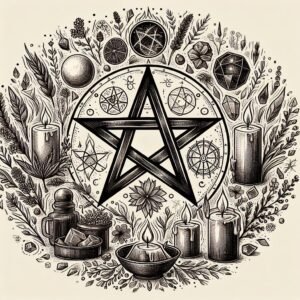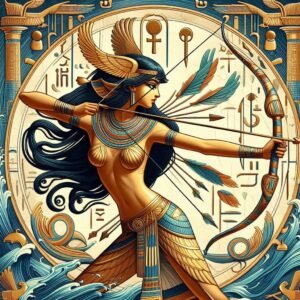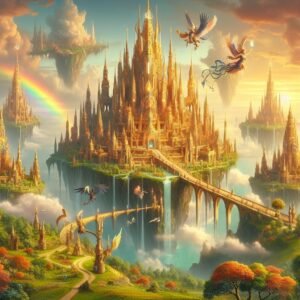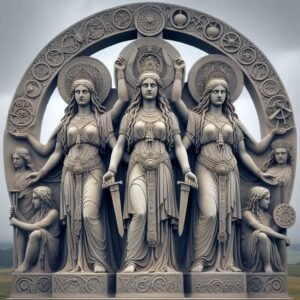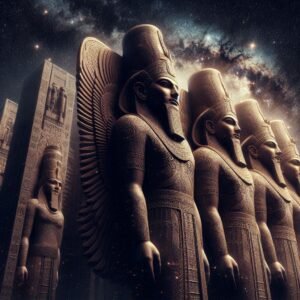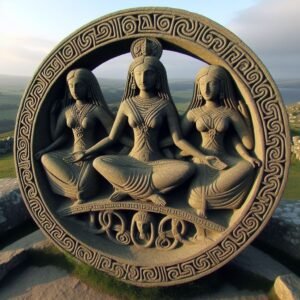
Ninsun, also known as Ninsumun, was a Mesopotamian goddess revered for her wisdom, beauty, and maternal care. She is best known as the mother of Gilgamesh, the hero of the Epic of Gilgamesh, and the wife of the deified king Lugalbanda. Ninsun’s name, which means “Lady of the Wild Cows,” reflects her association with bovine qualities, symbolizing nurturing and fertility. In the Epic of Gilgamesh, she plays a significant role by advising her son and interpreting his dreams. Ninsun was worshipped in various cities, including Uruk, where she had a major cult centre.
Ninsun appears in other myths beyond the Epic of Gilgamesh. She is mentioned in older Sumerian compositions, including “Gilgamesh and the Bull of Heaven,” where she plays a role in the narrative. Additionally, there is a poorly preserved myth describing her first meeting with Lugalbanda and their marriage. Ninsun is also sometimes associated with the goddess of medicine, Gula, in syncretic hymns. Her divine lineage and maternal attributes made her a revered figure in various Mesopotamian myths and religious practices.
Ninsun had several important roles beyond being the mother of Gilgamesh. She was revered as a goddess of wisdom and a divine protector, often providing guidance and interpreting dreams. Ninsun’s wisdom and guidance are central to her role in Mesopotamian mythology.
One of her remarkable abilities is dream interpretation; she helps Gilgamesh understand the symbolic meanings of his dreams, offering insights that guide his actions. Ninsun’s wisdom is also evident in her prayers to the sun god Shamash, seeking protection for her son. Her nurturing and protective nature, combined with her divine insight, make her a revered figure of maternal wisdom and guidance.
Symbology
Ninsun was often symbolized by the wild cow, reflecting her nurturing and maternal qualities. This association also extended to her wisdom and guidance, as she was revered for her ability to interpret dreams and provide insightful counsel. Additionally, her connection to the goddess of medicine, Gula, highlighted her role in healing and care, further emphasizing her wisdom.
Ninsun was associated with several other symbols. She was often depicted with imagery related to motherhood and royalty, reflecting her status as a divine mother and queen. Her temples and inscriptions frequently portrayed her as a protective and nurturing figure.
Centres of worship
Ninsun was worshipped in several ancient Mesopotamian cities, including Uruk, Ur, Lagash, and Nippur. Her main cult centre was the Emah Temple in Lagash, also known as the “Magnificent Temple”. This temple served as a gathering place for worshippers who sought her maternal grace and wisdom. Ninsun’s worship was particularly prominent among the royal families of the Third Dynasty of Ur. Additionally, she had a temple known as E-gula, or “big house,” though its exact location remains unspecified. Her temples were places of solace and reverence, reflecting her role as a divine mother and protector.
In Ninsun’s temples, particularly the Emah Temple in Lagash, various rituals and ceremonies were conducted to honour her divine essence. Priests and worshippers would offer prayers and perform sacred rites to seek her favour and protection. Symbolic offerings, such as food, drink, and possibly items representing fertility and motherhood, were presented to Ninsun. These ceremonies often included dream interpretation sessions, where Ninsun’s wisdom was invoked to understand and guide the dreams of the worshippers. The rituals emphasized her roles as a nurturing mother, a wise counsellor, and a protective deity.
Dream interpretation sessions in Ninsun’s temples were significant rituals where worshippers sought her divine wisdom to understand their dreams. These sessions involved priests or priestesses who acted as intermediaries, invoking Ninsun’s guidance to decode the symbolic meanings of dreams. Worshippers believed that dreams were messages from the gods, and Ninsun, with her profound wisdom, could provide insights and advice based on these dreams. The interpretations often guided personal decisions, spiritual journeys, and even communal matters, reflecting Ninsun’s role as a wise and nurturing deity.
In Mesopotamian culture, several deities were associated with dream interpretation. Nanna (also known as Sin), the moon god, was believed to grant visions and impart wisdom through dreams. Ishtar, the goddess of love and war, often appeared in dreams to guide or warn individuals. Shamash, the sun god, was seen as a bringer of light and truth, illuminating the meanings of dreams with his divine wisdom.
Subscribe to our post updates - Don't miss a thing!!

